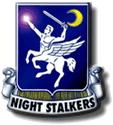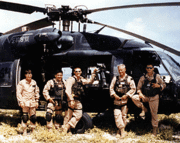Night Stalkers
|
|
Unit name
160th Special Operations Aviation Regiment (Airborne)
Abbreviated: 160th SOAR (A)
Nickname
Night Stalkers
Branch
Mission
Provide aviation support to U.S. Special Operations Forces
Headquarters
Motto
Night Stalkers Don't Quit (NSDQ)
Death Waits in the Dark
Regiment
3 battalions,
Training Company,
2 forward-deployed companies located in the U.S. Southern Command and the U.S. Pacific Command
Battalions
Aircraft
Established
October 16, 1981,
after the failure of Operation Eagle Claw
The 160th Special Operations Aviation Regiment (Airborne) —160th SOAR (A)— is a special operation force of the United States Army that provides aviation support by helicopters to general purpose forces and other special operations forces. Its missions include attack, assault, and reconnaissance, and are usually conducted at night, at high speeds and low altitudes, on short notice, and in secret. The force is headquartered at Fort Campbell, Kentucky.
The 160th SOAR (A) is also known as the Night Stalkers and its motto is Night Stalkers Don't Quit (NSDQ).
| Contents |
Overview
The 160th flies A/MH-6 Little Bird light helicopters, MH-60 Black Hawk assault helicopters and MH-47 Chinook heavy assault helicopters. [1] (http://www.soc.mil/160SOAR/Blkhawk.shtml) [2] (http://www.soc.mil/160SOAR/chinook.shtml)
The regiment consists of a headquarters company, the Special Operations Aviation Training Company, and three battalions: the 1st and 2nd at Fort Campbell, and the 3rd at Hunter Army Airfield, Georgia. It also has two forward-deployed companies: one apiece in the U.S. Southern Command and U.S. Pacific Command areas of responsibility. This allows the 160th to quickly assemble mixed forces to meet short-notice special operations needs.
The 160th SOAR (A) seeks the Army's best-qualified aviators and support soldiers. All must have volunteered and qualified for three increasingly tough jobs: Army, Airborne, and 160th SOAR (A). All receive intensive training upon joining the 160th. The basic Night Stalker course for enlisted soldiers lasts three weeks; the officer course 20 to 28 weeks. A new Night Stalker is designated fully mission qualified after a year or two, and earns flight lead qualification in three to five years.
The Night Stalkers pioneered many of the techniques and helped develop much of the equipment now used at night by other Army aviation units, and it continues to lead the service's advancement of these.
History
After the failure of 1980's Operation Eagle Claw, the disastrous attempt to rescue American hostages held in Tehran, President Jimmy Carter ordered former Chief of Naval Operations Adm. James L. Holloway III to figure out why it went wrong and how the U.S. military could best mount another attempt. One key lesson: there were no U.S. helicopter units trained in this kind of stealthy, short-notice special operations.
The Army looked to the 101st Aviation Battalion, which had the most diverse operating experience of the service's helicopter units, and selected elements of the 158th Aviation Battalion, 229th Aviation Battalion, and the 159th Aviation Battalion. The chosen pilots immediately entered intensive training in night flying. Dubbed Task Force 160, the new unit was quickly recognized as the Army's premier night fighting aviation force, and its only special operations aviation force.
As the first batch of pilots completed training in the fall of 1980, a second attempt to rescue the hostages was planned for early 1981. Dubbed Operation Honey Badger, it was called off when the hostages were released on the morning of President Ronald Reagan's inauguration.
The unit was officially established on October 16, 1981, when it was designated as the 160th Aviation Battalion.
The 160th first saw combat during 1983's Operation Urgent Fury, the U.S. invasion of Grenada.
In 1986, it was redesignated as the 160th Aviation Group (Airborne); in May 1990, the 160th Special Operations Aviation Regiment (Airborne). As demand for highly trained special operations aviation assets bloomed, the Regiment activated three battalions, a separate detachment, and incorporated one Army National Guard battalion.
In 1987 and 1988, its pilots took part in Operation Earnest Will, the protection of reflagged Kuwait tankers in the Persian Gulf during the Iran-Iraq War. They flew from Navy warships and leased oil barges in a secret subpart called Operation Prime Chance, and became the first helicopter pilots to use night vision goggles and forward looking infrared devices in night combat.
In June 1988, the unit executed Operation Mount Hope III. Two MH-47 crews flew 490 miles deep into Africa to steal an Mi-24 Hind attack helicopter.
Night Stalkers spearheaded Operation Just Cause, the 1989 invasion of Panama, and they were also used in Operation Desert Storm in 1991.
In October of 1993 in Somalia, Night Stalkers became involved in the Battle of Mogadishu, which later became the subject of the book and movie Black Hawk Down.
Operations
The 160th SOAR (A) has provided air support to most U.S. Army Rangers missions.
- Operation Urgent Fury - Grenada, 1983
- Operation Prime Chance - Persian Gulf, 1987–1988
- Operation Mount Hope III - recovery of Mi-24 Hind helicopter in Africa
- Operation Just Cause - Panama, 1989
- Operation Desert Shield - Iraq, 1990
- Operation Desert Storm - Iraq, 1991
- Operation Restore Hope - Somalia, 1993
- Operation Gothic Serpent - the operation that led to the Battle of Mogadishu.
- Operation Enduring Freedom - Afghanistan, 2001
- Operation Iraqi Freedom - Iraq, 2003
Famous Night Stalkers
Books and Movies
External links
Official sites
- 160th SOAR (A) fact sheet (http://www.campbell.army.mil/160soar.htm) at Fort Campbell
- 160th SOAR (A) fact sheet (http://www.soc.mil/160soar/soar_home.htm) at USASOC
Former Night Stalkers' websites
- Night Stalkers Association (http://www.nightstalkers.com/nsa/)
- NightStalkers.com (http://www.nightstalkers.com)
- SpecialOperations.com's unit profile (http://www.specialoperations.com/Army/160th_SOAR/)sl:160._specialnooperacijski_aviacijski_polk_(zračnoprevozni)


